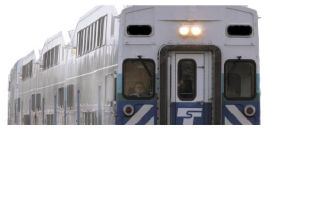At 6:05 a.m. Wednesday, the Coupeville Park and Ride kiosk held about six commuters, a few traveling into Seattle by three modes of transportation. Taking this “green route” consists of a bus ride on Island Transit, the Mukilteo ferry at 7:15 a.m., and a jaunt or extended 50 yard dash to the 7:23 a.m. Sounder Train to Seattle’s King Station.
“People make the commute because it’s beautiful to live here, but the jobs are better in Seattle and higher paying,” Coupeville commuter Tim McDonald said.
McDonald finished his almost 28 year tenure as Health Services Director for Island County Health at the beginning of April. He now serves the Snohomish Health District in Everett.
“I’ve met several people who’ve just taken jobs in Seattle because they can take the new Sounder. It’s an easy commute and it’s opened up a whole new job market,” McDonald said.
With more local residents taking advantage of the off-island market and also economizing on gas and car repairs, Whidbey News-Times staffers decided we needed some firsthand travel information.
News-Times reporters Liz Burlingame and Rebecca Olson began a two hour commute from Coupeville to Pike Street Market in downtown Seattle.
We met at the Coupeville Park and Ride on South Main Street a little before 6 a.m. The zero-fare transit system, Island Transit, was on time at 6:05 a.m. sharp.
“It’s really good at being on time, and the drivers are polite,” commuter Debbie Reilly said.
If you have a flashlight signal or use some vigorous handshaking, the bus will stop nearly anywhere along State Road 525. But the tired “packed like sardines” metaphor best describes the bus experience after stop number three.
McDonald said this is his only commuting problem; as gas prices rise, the buses become more crowded.
At 6:50 a.m., the bus stopped along a sidewalk leading to the ferry terminal. The fare from Clinton to Mukilteo is free for walk-on passengers, and $3.95 for the return trip. A multi-ride commuter card or a Clinton Puget Pass promise lower monthly rates.
The ferry was sparsely populated that morning. School teacher Derek Hanson, who rides the ferry for environmental reasons, thinks gas prices may convince more people to leave their car at home.
“I hope prices shoot up to $10. I’d like to see more people taking advantage of public transit. And they aren’t motivated by polar bears, they’re motivated by money,” he said.
Between 7:20 a.m. and 7:23 a.m., the time the ferry lands and the time the Mukilteo train leaves, commuters board the train. “When I stare out my window, I see people just running full sprint at the train. All they need is a few more seconds or minutes,” commuter Garry Hodson said.
That happened to us on Wednesday: Less than one minute shy of boarding. Rebecca and I watched as the train passed us, hands to our knees and sucking in deep breaths of air.
Two problems. There is no sign to direct passengers to the train stop, so we were running up the hill toward the other side of the track. Also, if choosing between high heels and tennis shoes, definitely opt for the latter.
A few commuters said they like to take the train in the evening and instead take a bus across the street from the ferry. Bus rates are $1.25 and the commute is longer, but they arrive at half hour intervals.
That evening, we had our second chance to board the train at 4:33 p.m. for about $3.25. The general feeling onboard was contentment. Or as Clinton to Seattle commuter Aurora Sosa put it, she “L-U-V, loves it.”
“It’s comfortable, clean, it isn’t noisy, there are no fumes from the buses or cars, it’s quicker, there are no Mariners delays and the view is beautiful,” Sosa said, referring to the train’s coastal route.
She added that if she drove everyday, the money spent would be astronomical. Her company reimburses most of the cost, but on average, she saves $78 a month.
The train arrived in Mukilteo at 5:15 p.m. and the ferry left at 5:30 p.m. For the most part, connection times were manageable and commuter Ken Stephens credits the increased coordination between the bus, ferry and train system.
“Even though it’s a brisk walk in the morning to catch the train, they tried to schedule the train back a bit. It leaves Everett, five minutes later than before, to cater to the ferry passengers,” Stephens said.
Stephens, on average, saves $50 to $60 every two weeks with his car-free commute.
Our final arrival time at the Coupeville Park and Ride was 7:15 p.m. A little tired but fairly relaxed, we talked with Coupeville commuter Kris Bruland who shared our commuting sentiments.
“I’m tired, but it’s way better than driving. I get to see the ocean view twice. Most people just get to watch the back of traffic,” Bruland said.
To try your own public transit trip, visit islandtransit.org, http://www.wsdot.wa.gov/ferries/, and www.soundtransit.org.



